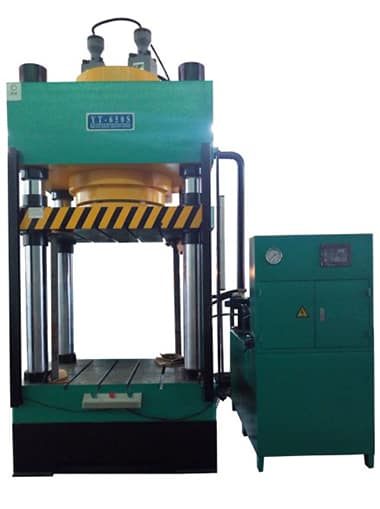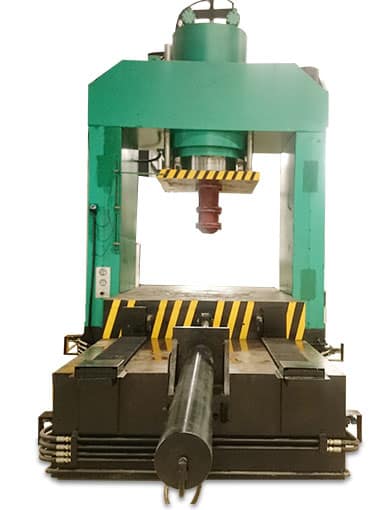Calculating Tonnage For a Hydraulic Press
time:2023-03-09 views:(点击 887 次)Hydraulic presses are an indispensable tool for fabricating metal parts, taking up minimal space but providing plenty of force. A hydraulic press makes a great addition to any workshop due its portability and power output.
A hydraulic press can exert thousands of pounds of force. To determine its tonnage, multiply the fluid pressure in pounds per square inch by the piston area in square inches and divide this result by 2,000 to get tons.
How to Calculate Tonnage for a Hydraulic Press
Knowing your tonnage requirements from the start is critical in the design process. Without precise dimensions, you could waste both time and money on a press that cannot produce your part.
Additionally, running a part in an industrial press with insufficient tonnage can cause damage and downtime. This is particularly true for Advanced High-Strength Steels (AHSS), which are becoming more widely used than ever before.
Hydraulic presses can generate thousands of pounds of force, which makes them ideal for forming metal parts. To calculate the force produced, you need to know both the rated pressure of a hydraulic cylinder and its piston area. You can do this using an equation: F=P=A, where P is pressure and A is piston area.
Capacity of Cylinders
Hydraulics relies heavily on cylinder piston surface area to regulate system pressure, force and speed. Thus, it's critical to correctly size the cylinder bore for your application.
It is essential to understand the load you are transporting. If it is a large and heavy piece of equipment, a larger bore will offer more capacity.
To determine the required cylinder bore size, you need to calculate both the pressure that the cylinder is operating at and its piston surface area. Use that number as your capacity in milliliters.
Hydraulic cylinders are designed by a team of engineers with consideration given to their environment and intended use. Furthermore, they take into account materials, coatings and seals needed for successful performance in any environment.
Capacity of the Ram
Hydraulic presses are capable of exerting tremendous force due to the fluid pressure on a piston. This pressure can be adjusted via manual or powered pumping elements.
The capacity of a Ram is what determines how much pressure an engine can deliver. A ram's capacity can be gauged by its piston diameter and maximum pressure it can generate.
A ram's capacity can also be determined by its length and travel distance. Generally, this length can be adjusted.
Some presses are equipped with a bolster, which is an upright plate or structure that supports the ram. This type of feature is commonly found on hydraulic presses as it ensures uniform blank holding during deep drawing operations.
Capacity of the Die
When selecting a die for your hydraulic press, there are several factors to take into account: the type of work being produced, how the tooling is set up and how much force will be needed to complete the task.
When tubular hydroforming, you may require a die with axial plungers on either end that create a watertight seal when the press ram closes.
You may require a die that can be run in return-on-pressure mode, where the ram lowers and extends to an established shut height. This feature enables you to lock the die shut without having to reset every time.
The return-on-pressure feature can be combined with dwell capability, the capacity to maintain a target force over an extended period of time. This is critical for processes which are susceptible to overshoot such as compaction and bulge forming.
Capacity of the Anvil
Hydraulic presses are widely used in industrial and manufacturing processes, from shaping machine components to crushing waste and compacting it. The pressure that a hydraulic press applies can range from several tons for manual models up to thousands of tons for motor-driven ones.
Different presses exist, each with its own frame and materials of construction. No matter its size or purpose, hydraulic presses remain an indispensable element in any manufacturing operation.
The capacity of anvil on a hydraulic press is determined by the number and size of each cylinder. The larger cylinders contain the ram, which pushes the anvil onto workpiece and forces it into die; smaller cylinders contain plungers which apply pressure to hydraulic fluid.
Link to this article: https://www.ihydraulicpress.com/yn/1377.html
Hot Articles
-
What Does a Hydraulic Press Do For Fruits and Vegetables?
Hydraulic presses utilize static pressure to produce finite and precise parts, components and assemblies. Their programmability enables creative e……
-
What Happens If You Hydraulic Press Oobleck?
Oobleck is a suspension of cornstarch and water that acts like both solids and liquids. The name derives from Dr. Seuss’ 1949 book Bartholomew……
-
What is the Difference Between a Hydraulic Press and a Vacuum Press?
A hydraulic press compresses a fluid between two cylinders, creating force which is then transmitted to the ram. Hydraulic presses are the workhorse……
-
What is a Hydraulic Press Juicer?
Hydraulic press juicers use hydraulic pressure to extract juice from fruits and vegetables without producing heat, thus protecting more of their nut……
-
Who Created the Hydraulic Press?
Hydraulic presses are closed systems that use liquid under pressure. First created in 1795 by Joseph Bramah – creator of the flush toilet R……
-
How Does a Hydraulic Press Work?
Hydraulic presses operate by applying Pascal’s law, using incompressible fluid (such as oil) as the conduit through which to transmit force. A……
-
What Is The Material For Hydraulic Press?
Hydraulic presses generate significant compressive force to straighten, bend, stamp or flatten materials into desired forms. They use fluid power ……
-
What Is a Hydraulic Press Capacity?
Hydraulic presses are an indispensable element of production and assembly processes, offering great versatility while helping minimize their footpri……
Latest News
-
Hydraulic Stamping Press
Hydraulic presses are essential tools in manufacturing. They produce parts for a variety of industries. Hydraulic presses utilize a ram and plunger ……
-
What Are the Advantages of a Hydraulic Press?
Hydraulic presses are highly versatile machines that can be used for a range of tasks. By altering dies, pressure, stroke speed or process position,……
-
What Is a Hydraulic Post Press Electric Platens?
Hydraulic press machines utilize hydraulic fluid in their cylinders to generate pressure that drives anvils and dies forward, acting like metal pipe……
-
The Benefits of a Heated Platen Press
A heated platen press is a versatile piece of equipment used for producing production parts requiring controlled temperature and pressure. It finds ……
-
What is a Hydraulic Press Used For in Metalworking?
A hydraulic press works by applying pressure to a liquid medium such as oil. This type of press operates according to Pascal’s principle and i……
-
What is the Hydraulic Press Principle?
A hydraulic press machine utilizes Pascal’s law to generate force by compressing a confined liquid. This principle states that pressure applie……
-
What is the Difference Between a Hydraulic Press and an H-Frame Press?
What is the Difference Between a Hydraulic Press and an H-Frame Press? Hydraulic presses work by applying pressure to drive a steel cylinder, or ram……
-
What is a Hydraulic Forging Press?
Hydraulic forging presses utilize liquid pressure to form and shape metal, and they can be employed for many tasks such as forging and cold working.……














































